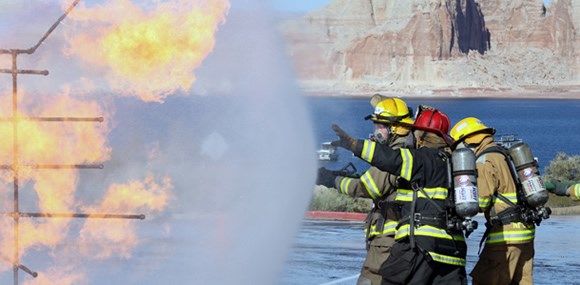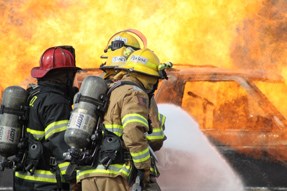Last updated: April 10, 2018
Article
Learning the Basics, Part 4-new
Day 6 — Live Fire!
Each of the fire crews got to participate in an observation burn, which allowed students to sit and watch fire behavior. The burn consisted of a giant pile of wood and paper set on fire inside a shipping container. The fire produced immense amounts of heat and smoke, magnified by the compartment. The gases and smoke would build up, causing a rollover fire, which at points was just inches from our PPE. We were able to see how the fire behavior changed when water was added to the fire, how the behavior would change if we cooled the overhead of the fire area, and what happened if the fire was allowed to burn.
The environment that the fire was started in was highly controlled, with three separate hose lines set up for safety, and three instructors inside with you. For me, it was especially important to witness this fire behavior because we have read about it and been taught about it, but had not actually seen it until today. There is no way to describe how uncomfortably hot it was. The PPE did its job protecting us, but with that kind of heat and smoke buildup, there really is no way that you can insulate yourself from the fire completely.
I felt completely safe because of the instructor guidance and experience but wonder if the excitement of seeing that fire behavior may have masked fears of being burned. It was not until after the fire was put out and I was observing other groups that I realized how bad a structure fire could be. The observation burn helped us understand our own physical and mental limitations when dealing with containerized fire. I am looking forward to seeing more fire in action during the second week of training.

NPS
Day 7 — Getting More Complex
Today was pretty much a repeat of day five with more complex tasks. The use of a fire department connection, which supplies water to existing sprinkler systems within buildings, was added to our skillset.
Day 8 — The Fire-Breathing Dragon
The morning's classroom lesson dealt with compressed natural gas fires and liquefied gas precautions. The subject, while not intrinsically interesting, is definitely a relevant one for anybody that wants to fight fire in the national parks. This is because of the prevalence of propane in housing and concession areas of our parks, and the relative ease by which such fuel can ignite and cause an incident. Thinking of my park and district alone, at least half of the residences have propane tanks that fuel stoves, dryers, water heaters, and furnaces, which makes the prospect of a propane incident very real.
The past several days of didactic learning have paved the way for today's attack on a fire-breathing dragon. In this case we did not actually attack a mythical creature, but rather a maze of metal pipes that were squirting out flaming propane. The term “fire-breathing dragon” is one of the endearing terms that the instructors have given to the propane tree prop. The teams advanced towards the fire, capturing it in a cone of water from the hose. For me, it was almost unreal advancing towards the fire and ending up just inches from it and still being safe. It is quite intimidating to hear the roar of the propane on fire coming out of the tree. The heat is intense and the thought of trying to control it is daunting. The most important thing to remember is: left for life, right to fight, referring to the pattern selection on the nozzle. Turning the nozzle left gives the firefighter a very wide fog for protection. To slay the dragon, one must use a wide fog, which allows firefighters to move closer to the fire with the protection of water. You can definitely feel the radiant heat, but the ability to move the flame away is amazing. The slight turn of the nozzle to the right really directs the flame in a certain direction. Go too far to the right and the flame sneaks under and over the fog pattern, which can be dangerous. Maintaining a constant situational awareness is paramount. It teaches you that if you get tunnel vision, it can result in burns, or worse. You have to rely on training to make sure that the dragon is slain.
As day eight of the structural fire academy comes to a close, more and more of what the instructors are teaching us is coming together out on the proving grounds.

NPS
Day 9 — Adding to the Repertoire
Today I added a new skill to my repertoire, putting out fires in burning cars. The fire lesson for the day dealt with attacking fire raging inside of a motor vehicle and rescuing the occupants. The instructors set up two vehicles, one of which was filled with paper bundles and set on fire with propane, in a parking lot for the day's practicum.
Our fire attack crews were split in half for the day and each group of three took turns advancing towards the burning vehicles. Approaching a vehicle that is on fire can be done with a wide fog, just as we did with the dragon. Get up to the car and control the flame, look around the area, maintain that situational awareness. Once the fire is somewhat controlled with a wide fog, the transition is made to a narrow fog and the fire is directly attacked.
As soon as the water hits the flame, toxic hot spots, nasty, dark smoke billow out of the car making the attack harder. The smoke and steam coming out the car as it was extinguished was by far the hottest thing we felt during the exercise. Steam is extremely hot and if you aren't protected properly with PPE then it is possible you will get burned. Today's skills were the most interesting and exciting so far!
Tomorrow, Brandon and David's story about their experiences at the Glen Canyon Structural Fire Academy come to a conclusion and they will share some reflections about the two weeks they spent learning the basics of structural firefighting.
